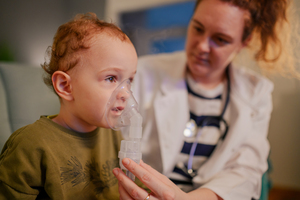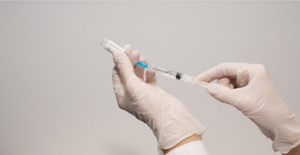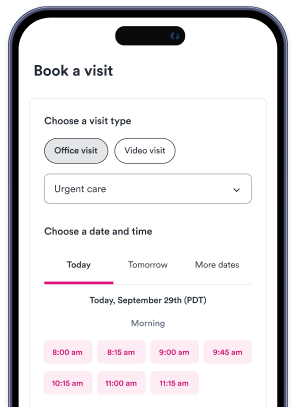Key points
- A fever in children is defined as a temperature of 100.4°F (38°C) or higher, with the method of measurement varying by age.
- Infants under 3 months should be taken to the ER for any fever, while older infants and children should be taken to urgent care for persistent or high fevers.
- Urgent care can diagnose the cause of the fever, provide appropriate treatment, and offer peace of mind.
- At home, mild fevers can be managed with hydration, light clothing, and fever-reducing medicine, but any changes in behavior should prompt a visit to the doctor.

Fevers are something most kids experience at some point, and as a parent, it’s natural to feel worried when your little one’s temperature rises. It’s tough to see them uncomfortable or not feeling like themselves. The good news is that not every fever means a trip to the doctor. Knowing when it’s time to head to urgent care can make all the difference in helping your child feel better — and giving you some peace of mind. Here’s a simple guide to help you decide when urgent care is the right call:
What qualifies as a fever in children
When it comes to kids and fevers, knowing what counts as a fever — and how to check for one — can save you a lot of worry. The American Academy of Pediatrics defines a fever in children as a temperature of 100.4°F (38°C) or higher. But how you take that temperature matters, especially depending on your child’s age:
- For infants under 3 months, a rectal thermometer is the most accurate way to get a reading.
- For toddlers and older children, oral, forehead (temporal), or ear (tympanic) thermometers can also provide reliable results, although each method may vary slightly.
It’s always a good idea to use the same method consistently so you can better track changes. Remember — if your child feels warm, acts differently, or just seems “off,” it’s worth checking their temperature to get some peace of mind.
When to take a baby or infant to urgent care for a fever
Fevers in babies can be scary, especially when they’re tiny and can’t tell you how they feel. For newborns up to 3 months old, even a slight fever of 100.4°F (38°C) or higher is a big deal — don’t wait, call your pediatrician right away or go to the ER.
For babies between 3 and 6 months, a fever over 101°F (38.3°C) or any fever that comes with signs of discomfort like poor feeding, unusual sleepiness, or irritability means it’s time to head to urgent care.
Once your baby is over 6 months, things get a little less urgent — but still important. If they have a fever over 102°F (38.9°C) that sticks around for more than 24 hours, or if they seem really uncomfortable or not acting like themselves, it’s best to get them checked out. Trust your gut — when in doubt, it’s always okay to reach out to an urgent care provider.
Red-flag symptoms that mean your child needs urgent care
Sometimes a fever is just part of a common cold — but other times, it’s a sign that something more serious is going on. If your child has a fever of 104°F or higher, it’s time to get them to urgent care. But it’s not just about the number on the thermometer:
- Pay close attention to how your child is acting. If they’re super sleepy, unusually cranky, hard to wake up, or just not acting like themselves, those are red flags.
- Signs of dehydration are also important to watch for, such as dry lips, a lack of tears when crying, or fewer than three wet diapers in a full day.
- Trouble breathing is another big one. If your child is breathing really fast, shallowly, or with a wheezing or grunting sound, don’t wait.
- The same applies to nonstop vomiting or diarrhea, or a rash that spreads quickly or resembles bruises, especially if accompanied by a fever.
Remember, when in doubt, it’s better to play it safe and get checked out at your nearest urgent care center.
What can urgent care do for a child with a fever?
If your child has a fever and you bring them to urgent care, the goal is to figure out what’s causing it and help them start feeling better. The provider will do a full check-up and ask about symptoms to determine whether the fever is from a viral illness like the flu or RSV, or something bacterial like an ear infection or a UTI.
In many cases, they can run quick tests right there in the clinic, like flu swabs, strep tests, COVID tests, RSV checks, or a urinalysis. Once they know what they’re dealing with, they’ll talk to you about the best way to treat it. That could mean giving your child medicine like Tylenol or Motrin to bring the fever down, prescribing antibiotics if it’s a bacterial infection, or helping with hydration if your child is struggling to drink fluids. Ultimately, you’ll leave with answers, a plan, and peace of mind.
When to go to the ER instead of urgent care
Urgent care is a great option for many fevers, but there are times when the emergency room is the safer choice:
- If your baby is under 3 months old and has any fever at all, don’t wait — go straight to the ER or call your pediatrician immediately.
- You should also head to the ER if your child has a seizure, even if it seems like a fever is causing it.
- Other serious signs include trouble breathing, lips or skin that appear blue, or a fever that doesn’t subside even after taking medication like Tylenol or Motrin.
- One of the biggest red flags to watch for is symptoms of meningitis, which can include a stiff neck, sensitivity to light, confusion, or a child who just isn’t responding normally.
These aren’t things you want to wait out — trust your instincts and get emergency care if anything feels off.
How to care for a mild fever at home
When your child has a mild fever but seems mostly okay, there’s a lot you can do at home to help them feel better, according to Boston Children’s Hospital:
- Start by ensuring they stay hydrated — offer plenty of fluids, such as water, juice, or even popsicles, if that’s all they’ll accept.
- Keep them in light, breathable clothing so their body can cool down naturally, and avoid bundling them up in heavy blankets.
- If they seem uncomfortable, you can give fever-reducing medicine like Tylenol or Motrin, but always follow the dosage instructions based on their age and weight.
Most importantly, keep a close eye on how they’re acting. If they’re still playing, eating, and responding to you, chances are the fever is nothing serious. But if their symptoms change or they start to seem more unwell, don’t hesitate to call your pediatrician or head to urgent care.
Need fast care for your child’s fever? Find urgent care near you with Solv
Don’t wait and worry—use Solv to quickly find pediatric-friendly urgent care centers near you with same-day appointments and short wait times. Get the care your child needs when you need it most.
FAQs
What temperature is considered a fever in children?
The American Academy of Pediatrics defines a fever in children as a temperature of 100.4°F (38°C) or higher.
When should I take my infant to urgent care for a fever?
If your newborn is up to 3 months old and has a fever of 100.4°F (38°C) or higher, you should seek immediate medical attention. For babies between 3 and 6 months, a fever over 101°F (38.3°C) or any fever accompanied by signs of discomfort like poor feeding, unusual sleepiness, or irritability means it’s time to head to urgent care. For babies over 6 months, a fever over 102°F (38.9°C) that lasts for more than 24 hours, or if they seem really uncomfortable or not acting like themselves, it’s best to get them checked out.
What are some red-flag symptoms that indicate my child needs urgent care?
Red-flag symptoms include a fever of 104°F or higher, unusual sleepiness, irritability, signs of dehydration like dry lips or fewer than three wet diapers in a day, trouble breathing, nonstop vomiting or diarrhea, or a rash that spreads quickly or resembles bruises.
What can urgent care do for a child with a fever?
At urgent care, the provider will conduct a full check-up and ask about symptoms to determine whether the fever is from a viral illness like the flu or RSV, or something bacterial like an ear infection or a UTI. They can run quick tests right there in the clinic, and once they know what they’re dealing with, they’ll talk to you about the best way to treat it.
When should I go to the ER instead of urgent care for my child's fever?
You should go to the ER if your baby is under 3 months old and has any fever at all, if your child has a seizure, if they have trouble breathing, lips or skin that appear blue, or a fever that doesn’t subside even after taking medication. Other serious signs include symptoms of meningitis, which can include a stiff neck, sensitivity to light, confusion, or a child who just isn’t responding normally.









